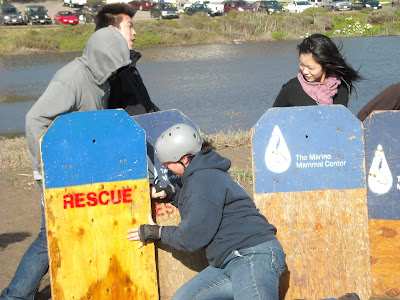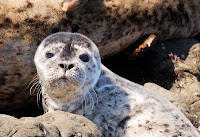The past few months have been a time of great transition in my life. This blog has temporarily taken a back seat, but I never stopped writing about nature and animals. In February, I pitched the publisher of
CoastViews Magazine on a story to inspire Coastside families to take stewardship of their local environment to help stranded marine mammals survive. The story, "
Here Come the Pups Again," appeared in the April 2010 issue and focuses on the pinniped pupping season on the California Coast.
As a volunteer for the
Marine Mammal Center, I have heard many stories about caring individuals like you and me, who walk right up to stranded sea mammals, allowing their dogs to approach the animal as well. It's an anomaly for most of us to encounter a marine mammal at all, so imagine how the seal feels encountering a human and a dog! Don't get me wrong - I'm not getting up on my high and mighty about this - I am a wildlife enthusiast, a nature lover and a take charge kind of person - as well as a writer - all reasons why I'd probably do the same thing, if it weren't for the Marine Mammal Center's training and incredible devotion to
community outreach.
 |
Northern California Elephant Seal
Photo by Nancy Whelan |
|
|
|
Last week, as part of my volunteer work, I went to Montara State Beach to observe an elephant seal that had hauled out on the beach. The Marine Mammal Center relies upon its volunteers along a 600-mile stretch of coast to go out and assess the condition of stranded animals.
I called in my assessment to the Center's Rescue Hotline and was relieved to learn that I was wrong about one thing: this seal was not dying. She was experiencing catastrophic molt, basically losing hair and a layer of skin, and her lethargic behavior was perfectly normal.
 |
Elephant Seal Montara State Beach May 7, 2010
Photo by Nancy Whelan | | |
|
Elephant seals generally tolerate human activity better than the other pinniped species, but I think this one finally grew a little weary of my photo taking! Graaaaa!
I tried to be as quick as I could, but I wanted a closeup of her right side, which seemed to have some lumps. This animal had a green "X" on her rump, marked by a previous volunteer who had checked on her the week before.
I got another call from the Center on May 8 - this time to assist with a rescue of the same seal. Based on other photos I had submitted, the Rescue Team decided this animal needed to see a veterinarian. However, when I arrived at Montara State Beach, the seal had gone back out to the ocean. Understandable. This was a Saturday and the beach was dotted with people and dogs. Can't a poor girl get a little rest? As of today, this seal has not re-stranded.











